#expedition 1990
Text
I would KILL for a video game set on Darwin IV from Wayne Barlowe's Expedition. Like are you seeing this shit???


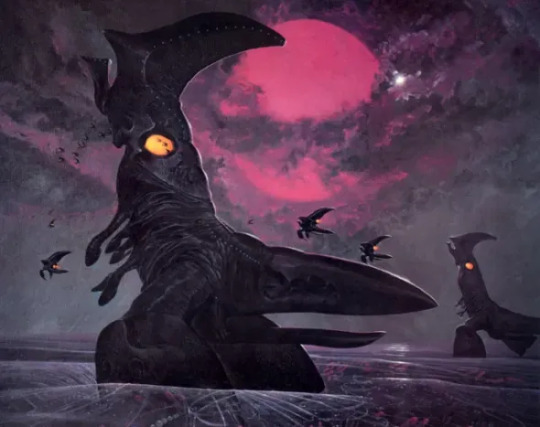

#i wanna get jumpscared by a butchertree let me get jumpscared by a butchertree#wayne barlowe#darwin iv#expedition 1990#losing my mind over this book#it's like dragonology for adults
101 notes
·
View notes
Text
Ted Raimi's characters as cats (Part 3)
21. Artist cat
The same bastard who breaks your things by looking you in the eye. It is because of him that every year you come up with new ways to secure the tree for Christmas and began to buy all decorations made of unbreakable materials. He can not stand the order in the house and arranges a garbage dump. Everywhere pops muzzle and paws, leaves traces at crime scenes. Your hand will not rise to punish him.

22. Cat of the main villain
Every self-respecting villain should have a furry purring friend who adds aesthetics, easy humanity, or vice versa demonic nature. If you're planning on being villainous, this curly version will suit you. Obedient, playful and well trained. However, still a kitten. If you make sure that nothing happens to him, then you can have a wonderful four-legged helper.

23. Artificial cat.
'Detroit: Become Human' would never have happened if people started creating not androids, but synthetic cats. Smart, adjusts to your needs, and doesn't require food or water. And also he does not require sleep, so at night he has too much freedom. Do not forget that synthetics have the ability to connect to the network and this cat is no exception, because it has a usb cable in its tail. Trust me, you don't want your cat to know your browsing history. Protect yourself from the gaze of judgment.

24. Trained kitten
He is a very smart boy and knows a lot of commands for such a small kitten. Non-conflict, peaceful and calm. With proper development, it will grow into an amazing friend and pet, which you will film and show to all people around, saying "look what a smart cat I have"! It may seem cowardly, but in case of danger it will be the first to rush at the offender to scratch out his eyes.

25. Adventurer cat
The same moron who climbs everywhere, and then cannot get out and will yell until you come and help him. You got better at keeping an eye on him when one day he was trapped inside the couch and you literally had to destroy him to free this fool. Playful and energetic, can sometimes hiss but quickly makes cute eyes to be forgiven. Sleeping in funny positions.
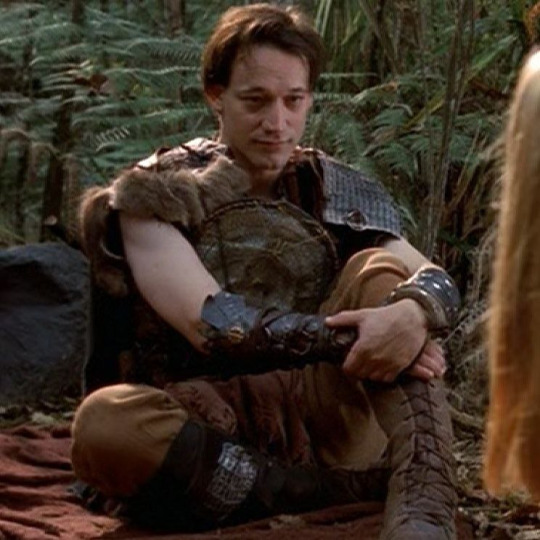
26. Vandal cat
You didn't want him in your house, but somehow he ended up here. It brings prey, but does not share, but leaves behind bloody footprints, and then watches with satisfaction as you clean up after it. Often hisses and hides so that you will not find him, no matter how hard you try. Sleeps on your face at night, trying to choke.

27. Loud cat
Here is such a little rubbish, and the sound is like a Jericho trumpet. the brightest star in the house and he knows it. If you wish, you can take it to various exhibitions and get decent places. He pretends to be proud and impregnable, but soon lies on the floor and tries to get your attention by meowing loudly. Loves to be brushed. Spoiled.

28. Distrustful kitten
Tired cat, but a mini version. Unapproachable and hissing loudly, he can even attack you and start scratching, and then he will hide from you throughout the house, fearing punishment for what he has done. When he gets used to you, he will be able to be near you. And somewhere in a year, he will also stick to you and will resist your attempts to remove him from you.

29. Frightened cat
He's seen all sorts of shit. Quiet and sleepy. It is better not to leave the baby alone for a long time, he begins to get scared and naturally cry when you return home. Sleeps with you in the same bed and likes to hide under the covers. When guests come to you, he immediately hides, and if someone finds him, he meows loudly and runs away. Sometimes he looks into empty corners and meows at them.
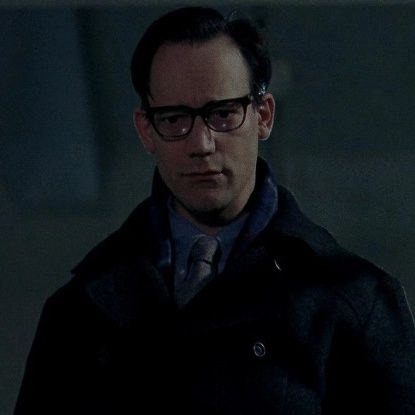
30. Therapist cat
Always there for you when you need it. Purrs soothingly and massages sore spots when you lie down. Guests do not like him, but he will still be next to you or on his knees. If they try to remove him, he will hiss and even wave his paw. Very dedicated. Recommended for people with anxiety.

>> Part 1
>> Part 2
#ted raimi#garage joe (CSI: NY)#rick (darkman 1990)#harry mudd (odyssey 5)#tim o'neill#seaquest dsv#joxer the mighty#jett (xena: warrior princess)#jace (xena: warrior princess)#yeah these three are included#ted parker (american gothic)#alex (the grudge 2004)#dr. coffee (the attic expeditions 2001)
24 notes
·
View notes
Text


By Erin Blakemore
October 25, 2023
More than 500 years ago, a 14-year-old girl was escorted up an Andean peak and sacrificed to Inca gods.
Buried on the mountain with a variety of offerings, the young woman’s body naturally mummified over time, preserving her hair, her fingernails, the colorful robes she wore on her last day.
But at some point across the centuries, her face became exposed to the elements, her features slowly vanishing over seasons of sunlight and snowfall.
Now, that long-lost face has been recovered thanks to painstaking archaeological analysis and forensic reconstruction.
A striking 3-D bust of the young woman, known today as the Ice Maiden of Ampato, is the centerpiece of a new exhibit in Peru and part of an ongoing effort to understand the drama of human sacrifice practiced in the Andes half a millennium ago.
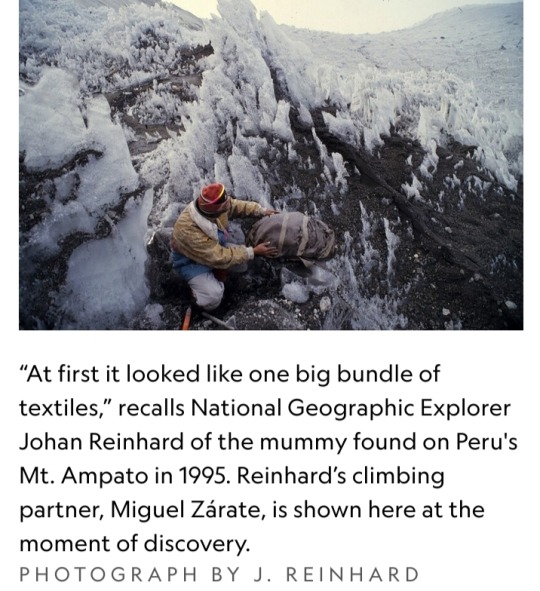
A sacrificial offering
When National Geographic Explorer Johan Reinhard encountered the mummy, also known as Juanita, atop 21,000-foot Mount Ampato during a 1995 expedition, he knew he had discovered something spectacular.
“At first it looked like one big bundle of textiles,” Reinhard recalls. Then he saw the wizened face amid the folds of fabric.
Here was a young victim of the elusive Inca ritual known as capacocha.
Capacocha mostly involved the sacrifice of children and animals who were offered to the gods in response to natural disasters — to consolidate state power in far-flung provinces of the Inca Empire, or simply to please the deities.
The ritual played an important part in sustaining the Inca Empire. It would involve feasts and grand processions to accompany the children, who appear to have been chosen for their beauty and physical perfection.
Being selected for sacrifice, researchers believe, would have considered a deep honor by the child’s family and community.
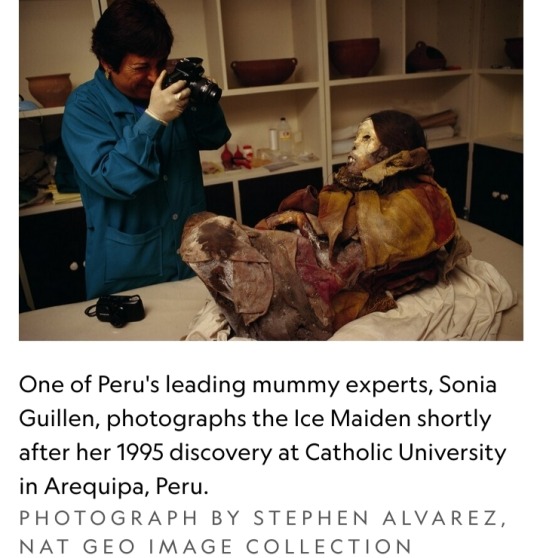
Most of the information we have on capacocha, however, is second hand, notes Dagmara Socha, an archaeologist with the Center for Andean Studies at the University of Warsaw who studies the ritual and commissioned the facial reconstruction of the Ice Maiden of Ampato.
“No European colonist ever saw the ceremony,” she explains.
Despite gaps in the historical record, the high-altitude archaeological finds of more than a dozen Inca children on Ampato and other mountains point provide critical evidence for what happened during these rituals.
The means of sacrifice varied, perhaps due to customs related to specific gods. Some children were buried alive or strangled; others had their hearts removed.
The Ice Maiden’s life ended with a single blunt-force blow to the back of the skull.
In search of the Ice Maiden
Oscar Nilsson knows that skull intimately: He spent months with a replica of it in his Stockholm studio, eventually fashioning a sculpture of the 14-old-girl that, glimpsed from afar, almost seems alive.
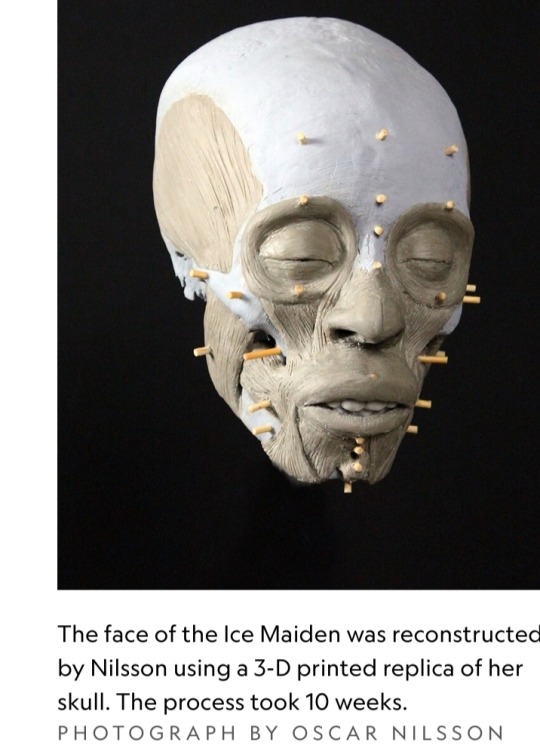
It’s a two-step process, says the Swedish archaeologist and sculptor.
First, Nilsson immerses himself in the world of his subject with an archaeologist’s eye for detail, digesting as much data as possible to understand what she might have looked like.
Even without a mummified face, he can extrapolate the likely depth of the facial tissue that once draped over those bones, using everything from CT scans to DNA analyses to information about diet and disease to make educated guesses about the individual’s face.
Then came the handiwork. Nilsson printed a 3-D replica of the Ice Maiden’s skull, plugging wooden pegs into its surface to guide the depth and placement of each hand-crafted, plasticine clay muscle.
Eerie eyes, masseter muscles, a nose, the delicate rope-like tissues that constitute a human face: each was added in turn.
After making a silicone mold of the bust, he added hundreds of individual hairs and pores in shades of brown and pink.
It took ten weeks.
Following the Inca Gods
The result, wrapped in robes woven by local women from Peru's Centro de Textiles Tradicionales, is the main attraction at “Capacocha: Following the Inca Gods” at the Museo Santuarios Andinos in Arequipa, Peru through November 18.
The reconstruction will be displayed alongside the Ice Maiden’s mummy, accompanied by the stories of 15 other children selected for capacocha atop Ampato and other Andean peaks.
Their ages range from 3 to about 13. The mummies and skeletal remains of several are featured as 3-D models at the exhibition, which also showcases holographs of some of the sacred items buried alongside them.
These natural mummies offer scientists tantalizing clues about their last days.
When Socha and colleagues conducted toxicological and forensic analyses of the remains of a toddler and four six-to-seven-year-old victims featured in the exhibition, they found they were well cared for in the months before their sacrifice.
They were fed a steady diet of coca leaves, ayahuasca vine, and alcohol in the weeks before their deaths — not as much to intoxicate them as to keep them sedated and anxiety-free as the timeline hurtled toward their sacrifice.
“We were really surprised by the toxicology results,” says Socha.
“It wasn’t only a brutal sacrifice. The Inca also wanted the children to be in a good mood. It was important to them that they go happily to the gods.”
High altitude, psychogenic substances, the spectacular view, the knowledge the afterlife was near — all must have made for an astonishing ceremony, says Reinhard.
“The whole phenomenon must have been overpowering.”
During the last phase of his reconstruction, Nilsson spent hours contemplating and attempting to capture the young girl’s presence 500 years after her death.
The result is both unsettlingly realistic and jarringly personal.
“She was an individual,” the forensic reconstructionist says.
“She must have understood her life would end on the mountaintop in a couple of weeks. We can only hope that she believed in the afterworld herself.”
For Reinhard, finally seeing the face of the girl he carried down the mountain on his back decades ago brought the Ice Maiden’s story full circle.
“It brings her back to life,” he says. The reconstruction brings the focus as much to her culture and daily life as to her spectacular death.
But Nilsson never forgot the way the Ice Maiden died, even as he brought her to life through his reconstruction.
More than anything, he says, he wanted to capture a sense of being frozen — a nod not just to her icy, mummified future but to a girl teetering on the edge of eternity, though still very much alive.
“She knew she was supposed to smile, to express pride,” he says. “Proud to be chosen. But still very, very afraid.”
#Ice Maiden of Ampato#Inca Girl#archaeological analysis#forensic reconstruction#human sacrifice#Peru#3-D bust#Juanita#Johan Reinhard#Mount Ampato#National Geographic#National Geographic Explorer#expedition#1990s#20th century#capacocha#Inca ritual#Inca Empire#Dagmara Socha#facial reconstruction#archaeology#archaeologists#Oscar Nilsson#sculptor#Centro de Textiles Tradicionales#Capacocha: Following the Inca Gods#Museo Santuarios Andinos#natural mummies#culture#forensic reconstructionist
1 note
·
View note
Text
The director of the New York Office of the High Commissioner for Human Rights of the UN (UN OHCHR), Craig Mokhiber, has resigned in a letter dated 28 October 2023
the resignation letter can be found embedded in this tweet by Rami Atari (@.Raminho) dated 31 October 2023.
The letters are here:

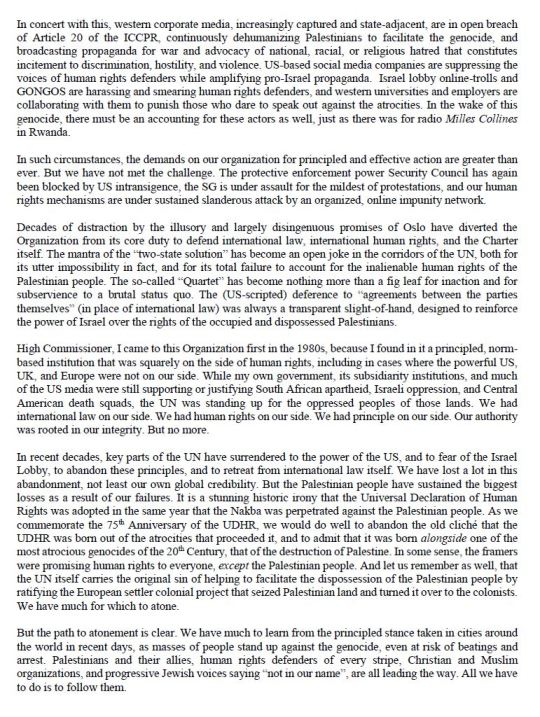


Transcription:
United Nations | Nations Unies
HEADQUARTERS I SIEGE I NEW YORK, NY 10017
28 October 2023
Dear High Commissioner,
This will be my last official communication to you as Director of the New York Office of the High Commissioner for Human Rights.
I write at a moment of great anguish for the world, including for many of our colleagues. Once again, we are seeing a genocide unfolding before our eyes, and the Organization that we serve appears powerless to stop it. As someone who has investigated human rights in Palestine since the 1980s, lived in Gaza as a UN human rights advisor in the 1990s, and carried out several human rights missions to the country before and since, this is deeply personal to me.
I also worked in these halls through the genocides against the Tutsis, Bosnian Muslims, the Yazidi, and the Rohingya. In each case, when the dust settled on the horrors that had been perpetrated against defenseless civilian populations, it became painfully clear that we had failed in our duty to meet the imperatives of prevention of mass atrocites, of protection of the vulnerable, and of accountability for perpetrators. And so it has been with successive waves of murder and persecution against the Palestinians throughout the entire life of the UN.
High Commissioner, we are failing again.
As a human rights lawyer with more than three decades of experience in the field, I know well that the concept of genocide has often been subject to political abuse. But the current wholesale slaughter of the Palestinian people, rooted in an ethno-nationalist settler colonial ideology, in continuation of decades of their systematic persecution and purging, based entirely upon their status as Arabs, and coupled with explicit statements of intent by leaders in the Israeli government and military, leaves no room for doubt or debate. In Gaza, civilian homes, schools, churches, mosques, and medical institutions are wantonly attacked as thousands of civilians are massacred. In the West Bank, including occupied Jerusalem, homes are seized and reassigned based entirely on race, and violent settler pogroms are accompanied by Israeli military units. Across the land, Apartheid rules.
This is a text-book case of genocide. The European, ethno-nationalist, settler colonial project in Palestine has entered its final phase, toward the expedited destruction of the last remnants of indigenous Palestinian life in Palestine. What's more, the governments of the United States, the United Kingdom, and much of Europe, are wholly complicit in the horrific assault. Not only are these governments refusing to meet their treaty obligations "to ensure respect" for the Geneva Conventions, but they are in fact actively arming the assault, providing economic and intelligence support, and giving political and diplomatic cover for Israel's atrocities.
Volker Turk, High Commissioner for Human Rights Palais Wilson, Geneva
In concert with this, western corporate media, increasingly captured and state-adjacent, are in open breach of Article 20 of the ICCPR, continuously dehumanizing Palestinians to facilitate the genocide, and broadcasting propaganda for war and advocacy of national, racial, or religious hatred that constitutes incitement to discrimination, hostility, and violence. US-based social media companies are suppressing the voices of human rights defenders while amplifying pro-Israel propaganda. Israel lobby online-trolls and GONGOS are harassing and smearing human rights defenders, and western universities and employers are collaborating with them to punish those who dare to speak out against the atrocities. In the wake of this genocide, there must be an accounting for these actors as well, just as there was for radio Mules Collins in Rwanda.
In such circumstances, the demands on our organization for principled and effective action are greater than ever. But we phave not met the challenge. The protective enforcement power Security Council has again been blocked by US intransigence, the SG [UN Secretary General] is under assault for the mildest of protestations, and our human rights mechanisms are under sustained slanderous attack by an organized, online impunity network.
Decades of distraction by the illusory and largely disingenuous promises of Oslo have diverted the Organization from its core duty to defend international law, international human rights, and the Charter itself. The mantra of the "two-state solution" has become an open joke in the corridors of the UN, both for its utter impossibility in fact, and for its total failure to account for the inalienable human rights of the Palestinian people. The so-called "Quartet" has become nothing more than a fig leaf for inaction and for subservience to a brutal status quo. The (US-scripted) deference to "agreements between the parties themselves" (in place of international law) was always a transparent slight-of-hand, designed to reinforce the power of Israel over the rights of the occupied and dispossessed Palestinians.
High Commissioner, I came to this Organization first in the 1980s, because I found in it a principled, norm-based institution that was squarely on the side of human rights, including in cases where the powerful US, UK, and Europe were not on our side. While my own government, its subsidiarity institutions, and much of the US media were still supporting or justifying South African apartheid, Israeli oppression, and Central American death squads, the UN was standing up for the oppressed peoples of those lands. We had international law on our side. We had human rights on our side. We had principle on our side. Our authority was rooted in our integrity. But no more.
In recent decades, key parts of the UN have surrendered to the power of the US, and to fear of the Israel Lobby, to abandon these principles, and to retreat from international law itself. We have lost a lot in this abandonment, not least our own global credibility. But the Palestinian people have sustained the biggest losses as a result of our failures. It is a stunning historic irony that the Universal Declaration of Human Rights was adopted in the same year that the Nakba was perpetrated against the Palestinian people. As we commemorate the 75th Anniversary of the UDHR, we would do well to abandon the old cliché that the UDHR was born out of the atrocities that proceeded it, and to admit that it was born alongside one of the most atrocious genocides of the 20th Century, that of the destruction of Palestine. In some sense, the framers were promising human rights to everyone, except the Palestinian people. And let us remember as well, that the UN itself carries the original sin of helping to facilitate the dispossession of the Palestinian people by ratifying the European settler colonial project that seized Palestinian land and turned it over to the colonists. We have much for which to atone.
But the path to atonement is clear. We have much to learn from the principled stance taken in cities around the world in recent days, as masses of people stand up against the genocide, even at risk of beatings and arrest. Palestinians and their allies, human rights defenders of every stripe, Christian and Muslim organizations, and progressive Jewish voices saying "not in our name", are all leading the way. All we have to do is to follow them.
Yesterday, just a few blocks from here, New York's Grand Central Station was completely taken over by thousands of Jewish human rights defenders standing in solidarity with the Palestinian people and demanding an end to Israeli tyranny (many risking arrest, in the process). In doing so, they stripped away in an instant the Israeli hasbara propaganda point (and old antisemitic trope) that Israel somehow represents the Jewish people. It does not. And, as such, Israel is solely responsible for its crimes. On this point, it bears repeating, in spite of Israel lobby smears to the contrary, that criticism of Israel's human rights violations is not antisemitic, any more than criticism of Saudi violations is Islamophobic, criticism of Myanmar violations is anti-Buddhist, or criticism of Indian violations is anti-Hindu. When they seek to silence us with smears, we must raise our voice, not lower it. I trust you will agree, High Commissioner, that this is what speaking truth to power is all about.
But I also find hope in those parts of the UN that have refused to compromise the Organization's human rights principles in spite of enormous pressures to do so. Our independent special rapporteurs, commissions of enquiry, and treaty body experts, alongside most of our staff, have continued to stand up for the human rights of the Palestinian people, even as other parts of the UN (even at the highest levels) have shamefully bowed their heads to power. As the custodians of the human rights norms and standards, OHCHR. has a particular duty to defend those standards. Our job, I believe, is to make our voice heard, from the Secretary-General to the newest UN recruit, and horizontally across the wider UN system, incisting that the human rights of the Palestinian people are not up for debate, negotiation, or compromise anywhere under the blue flag.
What, then, would a UN-norm-based position look like? For what would we work if we were true to our rhetorical admonitions about human rights and equality for all, accountability for perpetrators, redress for victims, protection of the vulnerable, and empowerment for rights-holders, all under the rule of law? The answer, I believe, is simple—if we have the clarity to see beyond the propagandistic smokescreens that distort the vision of justice to which we are sworn, the courage to abandon fear and deference to powerful states, and the will to truly take up the banner of human rights and peace. To be sure, this is a long-term project and a steep climb. But we must begin now or surrender to unspeakable horror. I see ten essential points:
Legitimate action: First, we in the UN must abandon the failed (and largely disingenuous) Oslo paradigm, its illusory two-state solution, its impotent and complicit Quartet, and its subjugation of international law to the dictates of presumed political expediency. Our positions must be unapologetically based on international human rights and international law.
Clarity of Vision: We must stop the pretense that this is simply a conflict over land or religion between two warring parties and admit the reality of the situation in which a disproportionately powerful state is colonizing, persecuting, and dispossessing an indigenous population on the basis of their ethnicity.
One State based on human rights: We must support the establishment of a single, democratic, secular state in all of historic Palestine, with equal rights for Christians, Muslims, and Jews, and, therefore, the dicmantling of the deeply racist, settler-colonial project and an end to apartheid across the land.
Fighting Apartheid: We must redirect all UN efforts and resources to the struggle against apartheid, just as we did for South Africa in the 1970s, 80s, and early 90s.
Return and Compensation: We must reaffirm and insist on the right to return and full compensation for all Palestinians and their families currently living in the occupied territories, in Lebanon, Jordan, Syria, and in the diaspora across the globe.
Truth and Justice: We must call for a transitional justice process, making full use of decades of accumulated UN investigations, enquiries, and reports, to document the truth, and to ensure accountability for all perpetrators, redress for all victims, and remedies for documented injustices.
Protection: We must press for the deployment of a well-resourced and strongly mandated UN protection force with a sustained mandate to protect civilians from the river to the sea.
Disarmament: We must advocate for the removal and destruction of Israel's massive stockpiles of nuclear, chemical, and biological weapons, lest the conflict lead to the total destruction of the region and, possibly, beyond.
Mediation: We must recognize that the US and other western powers are in fact not credible mediators, but rather actual parties to the conflict who are complicit with Israel in the violation of Palestinian rights, and we must engage them as such.
Solidarity: We must open our doors (and the doors of the SG) wide to the legions of Palestinian, Israeli, Jewish, Muslim, and Christian human rights defenders who are standing in solidarity with the people of Palestine and their human rights and stop the unconstrained flow of Israel lobbyists to the offices of UN leaders, where they advocate for continued war, persecution, apartheid, and impunity, and smear our human rights defenders for their principled defense of Palestinian rights.
This will take years to achieve, and western powers will fight us every step of the way, so we must be steadfast. In the immediate term, we must work for an immediate ceasefire and an end to the longstanding siege on Gaza, stand up against the ethnic cleansing of Gaza, Jerusalem, and the West Bank (and elsewhere), document the genocidal assault in Gaza, help to bring massive humanitarian aid and reconstruction to the Palestinians, take care of our traumatized colleagues and their families, and fight like hell for a principled approach in the UN's political offices.
The UN's failure in Palestine thus far is not a reason for us to withdraw. Rather it should give us the courage to abandon the failed paradigm of the past, and fully embrace a more principled course. Let us, as OHCHR, boldly and proudly join the anti-apartheid movement that is growing all around the world, adding our logo to the banner of equality and human rights for the Palestinian people. The world is watching. We will all be accountable for where we stood at this crucial moment in history. Let us stand on the side of justice.
I thank you, High Commissioner, Volker, for hearing this final appeal from my desk. I will leave the Office in a few days for the last time, after more than three decades of service. But please do not hesitate to reach out if I can be of assistance in the future.
Sincerely,
Craig Mokhiber
End of transcription.
Emphasis (bolding) is my own. I have added links, where relevant, to explanations of concepts the former Director refers to.
#Israel#Palestine#October 2023#28 October 2023#United Nations#Described#Long post#I’ll add more links to the things he is talking about later
15K notes
·
View notes
Text
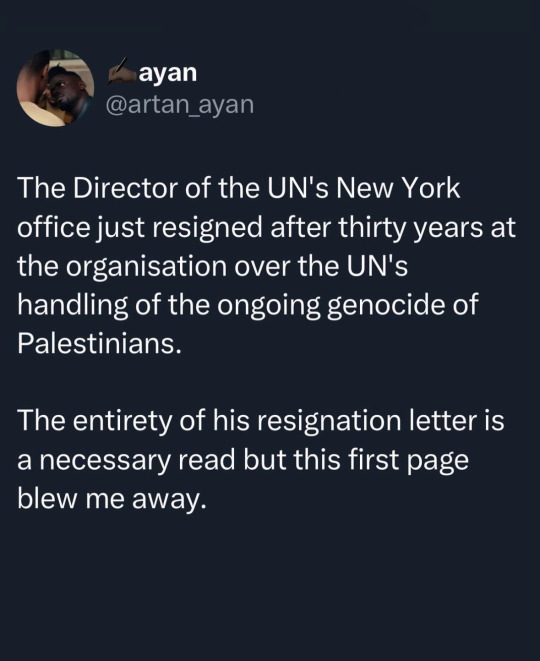
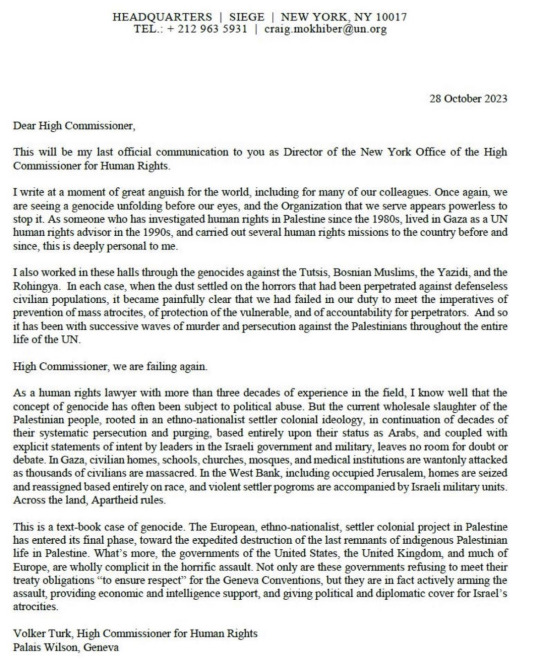
Dear High Commissioner,
This will be my last official communication to you as Director of the New York Office of the High Commissioner for Human Rights.
I write at a moment of great anguish for the world, including for many of our colleagues. Once again, we are seeing a genocide unfolding before our eyes, and the Organization that we serve appears powerless to stop it. As someone who has investigated human rights in Palestine since the 1980s, lived in Gaza as a UN human rights advisor in the 1990s, and carried out several human rights missions to the country before and since, this is deeply personal to me.
I also worked in these halls through the genocides against the Tutsis, Bosnian Muslims, the Yazidi, and the Rohingya. In each case, when the dust settled on the horrors that had been perpetrated against defenseless civilian populations, it became painfully clear that we had failed in our duty to meet the imperatives of prevention of mass atrocites, of protection of the vulnerable, and of accountability for perpetrators. And so it has been with successive waves of murder and persecution against the Palestinians throughout the entire life of the UN.
High Commissioner, we are failing again.
As a human rights lawyer with more than three decades of experience in the field, I know well that the concept of genocide has often been subject to political abuse. But the current wholesale slaughter of the Palestinian people, rooted in an ethno-nationalist settler colonial ideology, in continuation of decades of their systematic persecution and purging, based entirely upon their status as Arabs, and coupled with explicit statements of intent by leaders in the Israeli government and military, leaves no room for doubt or debate. In Gaza, civilian homes, schools, churches, mosques, and medical institutions are wantonly attacked as thousands of civilians are massacred. In the West Bank, including occupied Jerusalem, homes are seized and reassigned based entirely on race, and violent settler pogroms are accompanied by Israeli military units. Across the land, Apartheid rules.
This is a textbook case of genocide. The European, ethno-nationalist, settler colonial project in Palestine has entered its final phase, toward the expedited destruction of the last remnants of indigenous Palestinian life in Palestine. What's more, the governments of the United States, the United Kingdom, and much of Europe, are wholly complicit in the horrific assault. Not only are these governments refusing to meet their treaty obligations "to ensure respect" for the Geneva Conventions, but they are in fact actively arming the assault, providing economic and intelligence support, and giving political and diplomatic cover for Israel's atrocities.
Volker Turk, High Commissioner for Human Rights Palais Wilson, Geneva
Full letter
2K notes
·
View notes
Text
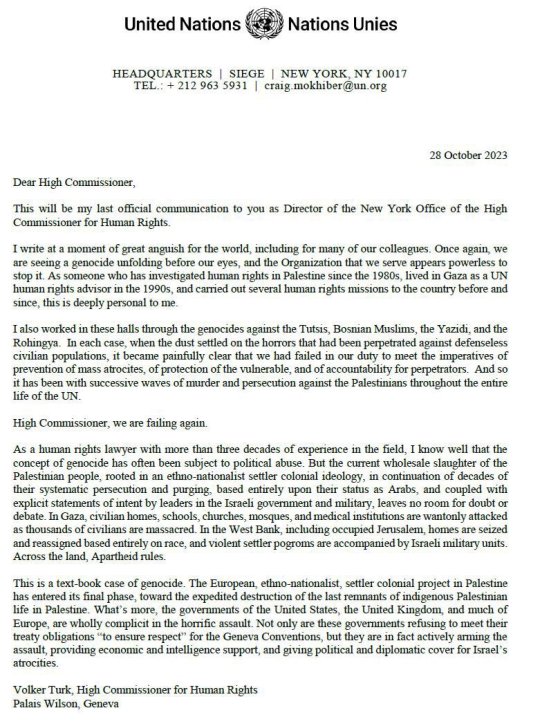
You MUST READ and disseminate the resignation letter of the High Commissioner for Human Rights, which speaks of a comprehensive plan for annihilation/genocide.
This resignation letter and message were written three days before the Jabaliya Massacre, in which many children and women tragically lost their lives!
You can read it from the image, or I will provide you with the text below to make it easier for you to read.
28 October 2023
Dear High Commissioner,
This will be my last official communication to you as Director of the New York Office of the High Commissioner for Human Rights.
I write at a moment of great anguish for the world, including for many of our colleagues. Once again, we are seeing a genocide unfolding before our eyes, and the Organization that we serve appears powerless to stop it. As someone who has investigated human rights in Palestine since the 1980s, lived in Gaza as a UN human rights advisor in the 1990s, and carried out several human rights missions to the country before and since, this is deeply personal to me.
I also worked in these halls through the genocides against the Tutsis, Bosnian Muslims, the Yazidi, and the Rohingya.
In each case, when the dust settled on the horrors that had been perpetrated against defenseless civilian populations, it became painfully clear that we had failed in our duty to meet the imperatives of prevention of mass atrocites, of protection of the vulnerable, and of accountability for perpetrators. And so it has been with successive waves of murder and persecution against the Palestinians throughout the entire life of the UN.
High Commissioner, we are failing again.
As a human rights lawyer with more than three decades of experience in the field, I know well that the concept of genocide has often been subject to political abuse. But the current wholesale slaughter of the Palestinian people, rooted in an ethno-nationalist settler colonial ideology, in continuation of decades of their systematic persecution and purging, based entirely upon their status as Arabs, and coupled with explicit statements of intent by leaders in the Israeli government and military, leaves no room for doubt or debate. In Gaza, civilian homes, schools, churches, mosques, and medical institutions are wantonly attacked as thousands of civilians are massacred. In the West Bank, including occupied Jerusalem, homes are seized and reassigned based entirely on race, and violent settler pogroms are accompanied by Israeli military units. Across the land, Apartheid rules.
This is a text-book case of genocide. The European, ethno-nationalist, settler colonial project in Palestine has entered its final phase, toward the expedited destruction of the last remnants of indigenous Palestinian life in Palestine.
What's more, the governments of the United States, the United Kingdom, and much of Europe, are wholly complicit in the horrific assault. Not only are these governments refusing to meet their treaty obligations to ensure respect" for the Geneva Conventions, but they are in fact actively arming the assault, providing economic and intelligence support, and giving political and diplomatic cover for Israel's atrocities.
Volker Turk, High Commissioner for Human Rights Palais Wilson, Geneva
#gaza#palestine#gaza strip#free gaza#free palestine#storiesfromgaza#غزة#فلسطين#genocide#humanitarian crisis
1K notes
·
View notes
Text







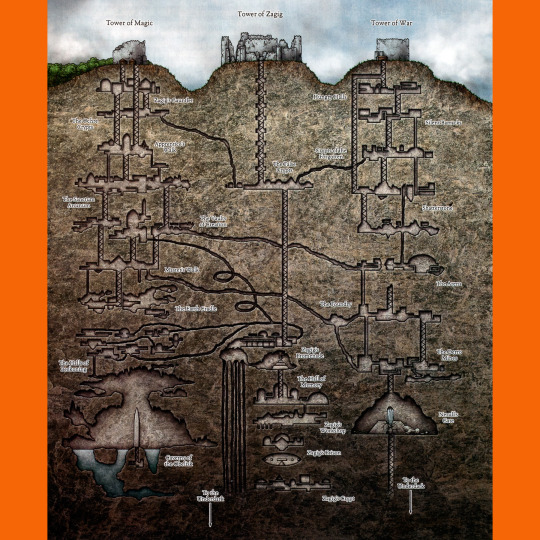
OK, this is Expedition to the Ruins of Castle Greyhawk (2007), a late-in-3.5E campaign book. It is a return of sorts — in 1990, TSR released WGR1: Greyhawk Ruins, which was an earnest attempt at creating a published version that matched the vibe Gygax’s ur-dungeon. That remains a somewhat obscure supplement, but forms the basic foundation of this campaign.
There is a fair amount of material on the city of Greyhawk and some important world lore before getting to the ruins themselves. The upper works are the remains of three towers — Zagig’s, Magic and War — each with voluminous, interconnected subterranean regions. These are vast, and not fully detailed. Rather, the book employs a system of encounter spaces and connections that creates an illusion of endless detail without the slog (or the page count). It feels super usable, with all the information for a given encounter (attributes, maps, tactics) all laid out on one or two pages.
I don’t know how I feel about it, though. It feels very very 3.5, for better and worse. Even allowing for that, this all feels somewhat disappointing, if only because it is trying to reconstruct a thing that never truly existed. The original, likely lost or unpublishable Greyhawk dungeon wasn’t a sensible place to explore, with a cohesive plot or anything like that. It was irrational, built on the fly literally to test new mechanics during the development of the game. It had a bowling alley for giants, and a portal to King Kong’s Skull Island. This book is, weird to say, too cool to be Castle Greyhawk. Or, at least, the Castle Greyhawk I am interested in reading about.
I don’t find the art direction very helpful. Michael Komarck’s cover has baldy Mordenkainen pondering his orb, in which a not-nearly-ruined-enough castle appears. Its the most distinct piece of art in the book, the rest of which is done by a gang of artists whose names I don’t recognize; it’s all workmanlike and adheres closely to the 3E art direction.
I dunno, this is fine, probably.
83 notes
·
View notes
Text
Five (5) 🖐🏻Disabled People from History that I wish people knew at a 5-year-old’s level
History is complex, and we need to discuss it with a far more nuanced view than we do.
But Disability History is lacking at even this most basic level, and you have to start somewhere. So:
1) Stephen Farfler
Was a paraplegic watch-maker. In 1655, he made a three-wheeled hand-driven cart for himself, inventing the crank, chain and gear mechanism that is now part of all modern bicycles.

[Image description: a contemporary black and white illustration of Stephen Farfler using the three-wheeled hand cycle he’d invented, demonstrating how the hand crank turns the front wheel. Description ends.]
2) Harriet Tubman
Harriet Tubman was severely injured when she defended a fellow slave from an overseer, and was hit in the head with a heavy metal object. Although this caused her pain and dizzy spells for the rest of her life, it did not stop her from working becoming a “conductor” on the Underground Railroad, nor did it stop her from being the first woman to lead an armed expedition in the American Civil War.
3) Louis Braille
Blind since childhood because of an accident, Louis Braille invented the tactile writing system named for him at the age of 15.
4) Margarete Steiff
Margarete Steiff contracted polio when she was a year and a half old. Her sisters and neighborhood friends helped her get to school by pulling her in a hand cart. When she grew up, she had a dress-making business, and made stuffed animals for children. Her most famous stuffed animal was a bear with jointed limbs that her nephew designed. It was the first Teddy Bear.
5) Justin Dart Jr.
He contracted polio and had to use a wheelchair in 1947, just before going to university. Even though he earned his degrees in history and education, and wanted to become a teacher, the university wouldn’t let him have his teaching certificate, because he was disabled. Many years later, he was appointed vice chair of the National Council on Disability, and led other government councils after that. He toured the USA with his wife twice, visiting each of the 50 states, and meeting with disabled people to learn about their struggles and how they were fighting for their rights. He helped write the language of the Americans with Disabilities Act, which was signed into law in 1990
---
There are many more things I wish people knew about, such as the intersection between class and disability, and between race and disability, and how the ADA isn’t strong enough to protect disabled people’s rights in the way they need to be protected.
But these are five reference-points that I figure are child friendly.
#Disability History#Disability Pride Month ♿#people we should learn about#bicycles teachers and bears oh my!
909 notes
·
View notes
Text
The Director of the UN’s New York office just resigned after thirty years at the organisation over the UN’s handling of the ongoing genocide of Palestinians.
The entirety of his resignation letter is a necessary read but the first page blew me away
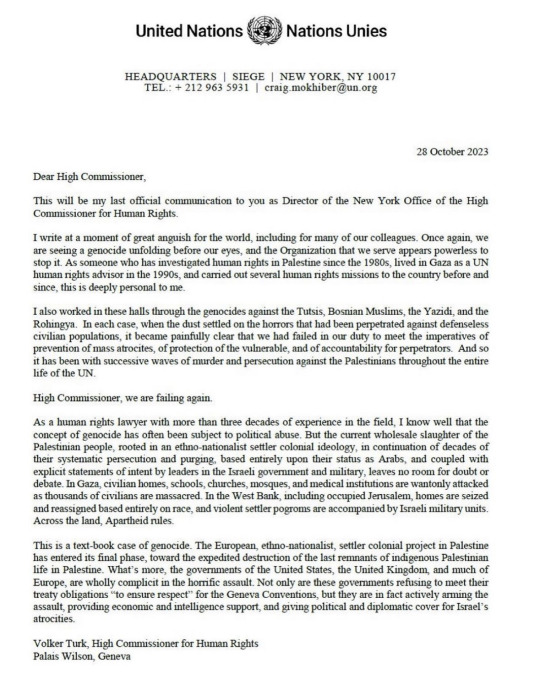
28 October 2023
Dear High Commissioner,
This will be my last official communication to you as Director of the New York Office of the High Commissioner for Human Rights.
I wrote at a moment of great anguish for the world, including for many of our colleagues. Once again, we are seeing a genocide unfolding before our eyes, and the Organization that we serve appears powerless to stop it. As someone who has investigated human rights in Palestine since the 1980s, lived in Gaza as a UN human rights advisor in the 1990s, and carried out several human rights missions to the country before and since, this is deeply personal to me.
I also worked in these halls through the genocides against the Tutsis, Bosnian Muslims, the Yazidi, and the Rohingya. In each case, when the dust settled on the horrors that had been perpetrated against defenceless civilian populations, it became painfully clear that we had failed in our duty to meet the imperatives of prevention of mass atrocities, of protection of the vulnerable, and of accountability for perpetrators. And so it has been with successive waves of murder and persecution against the Palestinians throughout the entire life of the UN.
High Commissioner, we are failing again.
As a human rights lawyer with more than three decades of experience in the field, I know well that the concept of genocide has often been subject to political abuse. But the current wholesale slaughter of the Palestinian people, rooted in an ethno-nationalist settler colonial ideology, in continuation of decades of their systematic persecution and purging, based entirely upon their status as Arabs, and coupled with explicit statements of intent by leaders in the Israeli government and military, leaves no room for doubt or debate. In Gaza, civilian homes, schools, churches, mosques, and medical institutions are wantonly attacked as thousands of civilians are massacred. In the West Bank, including occupied Jerusalem, homes are seized and reassigned based entirely on race, and violent settler pogroms are accompanied by Israeli military units. Across the land, Apartheid rules.
This is a text-book case of genocide. The European, ethno-nationalist, settler colonial project in Palestine has entered its final phase, toward the expedited destruction of the last remnants of indigenous Palestinian life in Palestine. What’s more, the governments of the United States, the United Kingdom, and much of Europe, are wholly complicit in the horrific assault. Not only are these governments refusing to meet their treaty obligations “to ensure respect” for the Geneva Conventions, but they are in fact actively arming the assault, providing economic and intelligence support, and giving political and diplomatic cover for Israel’s atrocities.
Volker Turk, High Commissioner for Human Rights
Palais Wilson, Geneva
#politics#united nations#UN#human rights#Gaza#gaza under attack#Palestine#free palestine#free gaza#occupation#genocide#war crimes#israel is an apartheid state#israel is committing genocide#Israel#idf#Zionism#usa#uk#Europe#colonization#geneva convention
68 notes
·
View notes
Text

Cryptid of the Day: Dodo
Description: The dodo is a staple of extinct animals caused by humans. They went extinct in 1690, but some have claimed to have seen them, even as late as 1930 on the island of Mauritius. Two expeditions were launched in the 1990′s, but found nothing.
95 notes
·
View notes
Text

Deeply personal iconic conflation of imagery and music circa 1990—Emperor Sea Strider skull from Barlowe's EXPEDITION + Andy LaRocque's "Insanity" instrumental from King Diamond's The Eye.
Your mileage may vary, but mine never will.
Expedition, Wayne Douglas Barlowe
Insanity, Andy LaRocque
29 notes
·
View notes
Text

Christopher McCandless, The Man who Hiked to Death
Born February 12th 1968, in Inglewood, California, Christopher McCandless was immediately plunged into a chaotic family. His sister, Carine McCandless, documented in her book ‘The Wild Truth’ that they shared their home with six half-siblings. Carine also alleged that her parents were abusive, both physically and verbally, toward the McCandless children. She documented how her father was an alcoholic, and their mother often fed off his evil energy, inflicting her own abuse upon them.
The McCandless never stayed in one place for long as Walt McCandless worked for NASA as a rocket scientist, taking him across the U.S. Eventually, the family settled in Virginia long enough for Christopher and Carine to graduate.
Following his graduation from university, Christopher knew he needed to travel. He had spent much of his childhood moving from town to town, state to state, and this had a profound impact on his outlook on life.
He only stayed in one place for a short time, seeing the beauty in exploring the world. In mid-1990, Christopher left Virginia for new pastures and began driving West. He stopped in towns and cities along the way, picking up odd jobs to make ends meet. By April of 1992, Christopher was itching for another adventure, and that is when he decided to make his way to Alaska, the final frontier of the U.S.
Incredibly, Christopher managed to hitchhike from Carthage, South Dakota, to Fairbanks, Alaska, a whopping 3,000+ miles through Saskatchewan, Alberta, British Columbia and Yukon, Canada. Eventually, he arrived, and he began planning his largest expedition yet. He wanted to hike through the Denali National Park. The park covers over 6,000,000 acres in the middle of Alaska. Communities are few and far between, with many Alaskans congregating near large towns and cities.
Despite the harsh weather conditions of Alaska, Christopher McCandless seemed ill-prepared. Fellow hikers and locals recalled seeing Christopher arrive in Fairbanks carrying only a backpack. He also stood out for his ‘Hippie-like’ appearance, choosing to remain unkempt and dirty. April 28th 1992, would mark the last day that Christopher McCandless would ever see the seeds of civilisation.
That day, Jim Gallien was flagged down by Christopher, who was looking for a ride to the Stampede Trail in the Denali National Park. Gallien later told author Jon Krakauer that he had doubts about the 24-year-old’s survival from the start. When he got into his car, Christopher had minimal clothing and a backpack. Christopher explained that he was carrying a 10 lb bag of rice, a Remmington semi-automatic rifle and a pair of Wellington boots inside his bag. Gallien was, in fact, so concerned that he offered to drive Christopher to Anchorage so that he could purchase the necessary equipment for him. He knew how harsh and unforgiving the Alaskan landscape could be, and per population, it has an alarmingly high missing persons rate. Throughout their drive, Christopher assured Gallien that he would be fine and had hiked many times before.
It wasn’t until months later that Gallien learned Christopher’s real name, as when he had picked him up, he had simply given the name ‘Alexander Supertramp’. The only item that Christopher accepted from Gallien was a map. Before leaving, Christopher asked Gallien to snap a picture of him at the Stampede Trail, making this one of the last photographs ever taken of Christopher McCandless.
For two days, Christopher hiked the Alaskan wilderness, soaking in the beauty of the Denali National Park. After a gruelling march, Christopher made it to an abandoned blue and white bus. Whilst the exterior was rusted and hadn’t been loved for some time, Christopher recognised it was the perfect shelter and base camp. He wasted no time setting up his gear and prepping his new home.
The blue and white bus that would become a notorious tourist hotspot was not Christopher’s intended finish line. According to his diary, which was later discovered with his body, Christopher had planned to hike through the park and to the Bering Sea. Christopher remained at the blue and white bus for two months, eagerly journaling every step. Christopher wrote in his diary that he had begun consuming the roots of the Hedysarum Alpinum plant. Christopher also detailed in his diary how he had trapped and hunted small game and wildlife. He had successfully hunted a moose/caribou with his rifle. However, the meat was rotten by the time he came to consume it. With just 10 lbs of rice and foraged plants, Christopher rapidly began losing weight.
The lack of food and people was beginning to get to Christopher, who heavily documented his trip via his journal and camera. On July 3rd 1992, Christopher packed up his things, leaving the blue and white bus behind.
With a map in hand, Christopher hoped to reach civilisation once more, but the landscape had changed and he became distressed and returned to the blue and white bus to wait out the days until the river froze over once more.
On July 14th, he also began to incorporate the seeds of the Hedysarum Alpinum plant into his diet, as was documented in his diary. The meagre diet of plant material and small animals was nowhere near enough to sustain Christopher, who continued to waste away. As he continued to weaken, he lost his energy and ability to forage further afield for plants and fruits.
Christopher McCandless made his final diary entry on what he noted as ‘Day 107’. The entry simply reads, “Beautiful blue berries.” Author Krakauer noted that days 108 through 112 had / (slashes) but no words, and after Day 113, no more entries were made. Sometime around these final diary entries, Christopher wrote, “I have had a happy life and thank the Lord. Goodbye, and may God bless all.” It is clear Christopher knew his end was coming, and he had made his final preparations and peace with his fate.
It wasn’t until September 6th 1992 that the grizzly truth would be revealed.
That day, hikers in the Denali National Park came across the blue and white rusted van that Christopher had once called home.
These hikers had the same idea as Christopher and were eager to use the bus as shelter.
When they approached the bus, they found a note taped to the door which read “Attention possible visitors. S.O.S. I need your help; I am injured, near death and too weak to hike out. I am all alone; this is no joke. In the name of God, please remain to save me. I am out collecting berries close by and shall return this evening. Thank you, Chris McCandless, August.”
As they moved through the bus, they saw the familiar outline of a human in a sleeping bag. After reading the note, they hoped that Chris had managed to survive, but all hopes were dashed when the stench of decay overcame them. The hikers took a closer look, and their worst suspicions were confirmed. Christopher McCandless was deceased, his body decaying in a sleeping bag in the back of a rusted-out bus.
Alaska State Troopers and Denali Park staff were summoned to the bus where Christopher’s body was recovered. His family were notified of the terrible news, and preparations for his body to be returned to Virginia were made.
Christopher’s passing marked a turning point in the culture surrounding hiking and travelling. He had wilted away in the wilderness when a bridge and cabin were within a few miles of his location.
17 notes
·
View notes
Text

'christian francis roth scuba jacket, 1990, model pamela telford' in expedition: fashion from the extreme - thames + hudson (2017)
22 notes
·
View notes
Text
The framing narrative of Mary Shelley's Frankenstein, Robert Walton's search for the north magnegic pole, is set sometime in the latter half of the 18th century. The pole, which was eventually found in 1831, shifts over time, but until the 1990s it was isolated within the Canadian archipelago

Walton gave up the expedition and turned back before they found the pole, so it's safe to assume his ship was east of Victoria Island, probably near Boothia Peninsula (the red dots marked 1831 and 1904).
This is the exact location the Terror and Erebus would later become stranded during the lost Franklin expedition of 1845.

The exact year of Walton's story is never specified, but Mary Shelley wrote it in 1816 and probably intended it to be set in the recent past, so lets say 1780s or 1790s, 50 or 60 years before Franklin's crew became trapped in the ice. Frankenstein's monster is inhumanly large and inhumanly strong, so there's no reason to believe he wouldn't also have an inhumanly long lifespan (and hey, he was just created, maybe his internal clock still says he's a baby, so 50 or 60 years isn't even that old).
What I'm saying is, instead of self-immolating in Victor's funeral pyre, maybe Adam continued to wander the Arctic, and eventually settled in an Inuit village. He can fish, he can hunt, he can ward off polar bears, he would be a welcome addition to the isolated community, and when the Terror happens, let's just say Captain Crozier is surprised to meet someone out on the ice who can speak English, especially a hulking 8-foot mass of a man.
#fanfiction#fan fiction#fanfic#frankenstein#the terror#hms terror#hms erebus#franklin expedition#frankenstein's monster#adam frankenstein#mary shelly's frankenstein#mary shelley#crossover#canada#arctic#robert walton#victor frankenstein#captain Crozier#francis crozier#northwest passage
336 notes
·
View notes
Text
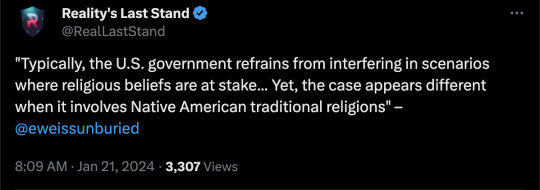

By: Elizabeth Weiss
Published: Jan 20, 2024
Recently, the Navajo Nation has embarked on a mission to stop flights to the moon, especially those intending to deposit human cremated remains (commonly referred to as “cremains”). The Navajo Nation regards the moon as sacred, arguing that depositing cremains—or any objects, for that matter—constitutes an act of desecration. This controversy centers around the Peregrine Mission 1, a NASA-spon.sored expedition to the moon. Two private companies, Celestis and Elysium Space, plan to use this mission to transport the cremains of individuals who opted for a lunar resting place.
Upon receiving a letter from Buu Nygren, the Navajo Nation’s President, the White House convened a meeting to hear their objections to those flight plans. Although the White House correctly concluded that the government did not have the authority to stop the flight or hinder the private companies’ plans, one may wonder why these religious concerns of the Navajo Nation were ever seriously considered in the first place. Typically, the U.S. government refrains from interfering in scenarios where religious beliefs are at stake, as evidenced by the longstanding conflict between fundamentalist Christian creationists and the teaching of evolution in schools.
Yet, the case appears different when it involves Native American traditional religions—a loosely defined amalgamation of beliefs, often intertwined with Christian elements, and lacking formal sacred texts. In these instances, the US government has been bending the First Amendment of the Constitution so greatly that it is bound to snap.
The First Amendment of the US Constitution clearly states, “Congress shall make no law respecting an establishment of religion.” This means that the federal government should be neutral towards all religions, avoiding favoritism to any denomination. Although the U.S. Government generally avoids supporting or discriminating against specific religions, as demonstrated by the diverse holiday displays ranging from nativity scenes to the Satanic Temple altar in Iowa, traditional Native American religions have been the exception to this strict adherence to the First Amendment’s Establishment Clause.
This exception is evident in NASA’s collaboration with the Navajo. In NASA’s 108-page education guide, “Story of the Stars,” intended for “Classrooms and Community-Based Educational Events,” Navajo religious beliefs are treated as being of equal importance to NASA’s scientific research. On page 3, the guide contains a statement from the Navajo: “We are the Holy People of the Earth. We are created and placed between our Mother Earth and Father Sky.” Further evidence of religious support in this guide is a story stating, “After the creation of the Earth, sky, and the atmosphere, the Holy people realized the whole university was entirely dark.” It is interspersed with tales of sacred directions, seasons, beliefs, and rules of life. Notably, in the acknowledgements, Leland Anthony Jr. is listed as the project’s “spiritual advisor.”
Given this content on NASA’s website, it’s hardly surprising that the White House would hastily convene a meeting with the Navajo Nation to consider the validity of objections to moon flights. However, these considerations favor one religion and teach one religion, thereby violating the US Constitution.
Another example of the Federal government showing a denominational preference appears in the Native American Graves Protection and Repatriation Act (NAGPRA). Enacted in 1990, NAGPRA aids in the repatriation and reburial of human remains and artifacts deemed “sacred,” or as grave goods, or objects of cultural patrimony. A specific instance of this favoratism within NAGPRA is the requirement that at least 2 of the 7 individuals on the review committees “must be traditional Indian religious leaders.” Additionally, each NAGPRA meeting begins and ends with a “traditional Indian prayer.” For example, Armand Minthorn’s prayer at the January 5, 2023 meeting started with, “Today, as we come together, we thank our Creator for our life, our family, and our friends. And we ask our Creator today to give us strength and courage to go on and go forward.”
Perhaps most troubling is the acceptance of Native American religious creation myths as evidence for present day tribal affiliation to past populations. These tales have been leveraged to empty museums and universities of research collections–collections that might otherwise contribute to advancements in forensic identification techniques, aiding today’s Native American crime victims.
Final examples of the US government supporting Native American religions involve discriminatory practices based on sex. For instance, at the Smithsonian Arctic Studies Center, religious traditions led Inuit elders to forbid female archaeologists from handling certain artifacts. Similarly, when the California Department of Transportation archaeologists collaborated with the Kashaya Pomo tribe, the tribe’s religious protocols dictated that menstruating women be isolated, prohibited from conducting fieldwork, kept away from Native elders, and forbidden from talking about spiritual topics!
It is time for the US government to stop its unconstitutional denominational preference of Native American religions. Stopping these preferences would uphold the First Amendment’s Establishment Clause, protect scientific endeavors, and prevent discriminatory practices.
==
You shouldn't be any more comfortable with the Navajo making demands based on their religion than Xianity or Islam. Being loosely defined and vaguely "spiritual" doesn't change any of that.
Imagine an Orthodox Jew dictating "that menstruating women be isolated, prohibited from conducting fieldwork, kept away from Jewish elders, and forbidden from talking about spiritual topics" and being able to get traction and compliance from the government (and government institutions).
Your religion's rules apply to you, not me. If your religion forbids putting cremains on the moon, don't send any cremains to the moon. If your religion demands the moon be honored, go honor the moon. Over there.
#Elizabeth Weiss#Navajo Nation#Native American religions#First Amendment#US Constitution#Establishment Clause#secularism#separation of church and state#freedom of religion#indigenous religions#religion#religion is a mental illness
15 notes
·
View notes
Text



Mr and Mrs Mountain: In Conversation with Steve and Jo Harrington
(National Geographic, 1993)
I sit down with the Harringtons on a sunny day in December in the living room of their Boulder Colorado home. They’ve just moved in, and they apologize for the few stray boxes still littering the dark wood floors.
“We’re not used to having all this space,” admits Steve Harrington, going on to describe how he and his wife spent most of the last three years living in sublets, tents, and the errant hostel, jumping from Boulder, where they’ve decided to call home, to various parts of the world for an awe-inspiring roster of expeditions. But their most frequently-visited location is Everest, of course.
“We leave around mid-March and can usually expect to be back in June. It’s become a pretty well-oiled machine by now.” What Harrington is referring to is their expedition outfit, Summit Trek, that has been in business since 1991. It’s 1993 when I sit down with the Harringtons, and they’re confirming their client list for an Everest expedition… in 1996. The next three years have already been all booked up. Why, you ask, does this young yet affable couple have a veritable waitlist to join their outfit? It’s simple, they’ve never lost a single client on any of their ascents, a rare feat for repeat Everest expedition guides.
“We really take a lot of pride in the safety of our trips. There’s more and more outfits every year that are willing to take clients up Everest, but it’s always been the getting back down that’s the tricky part,” says Jo Harrington, sitting on the arm of their worn leather couch, her arm draped loosely over her husband’s shoulders. She carries herself with a great deal more poise than her twenty-six years may allow her, a sort of wry steel to the way she speaks, chin tilted down, daunting and demure at the same time, as if Catherine Hepburn and Clint Eastwood had a lovechild with a particular athletic prowess. She wears her hair in two short braids, flyaways framing sharp eyes and dark brows. In a pair of rumpled khaki cargo pants and a thermal with the patagonia logo stitched into the chest (she has been sponsored by the brand for four years now), there is still a strange elegance to her, carried in quick hand gestures and a permanently rasped voice. First brought into the climbing world’s consciousness at the age of sixteen for taking home gold in the 1983 Climbing National Championships in her age division, Harrington, nee Taylor, would go on to rack up an impressive resume of climbs. She currently has conquered five of the seven continental summits, and still holds the women’s speed record for climbing El Cap.
“I’m going for Steve’s record the next time I get out to Yosemite,” quips Jo while her husband grins up at her. He currently holds the men’s speed record on El Cap.
Indeed, the Harringtons have become darlings of the climbing world, meeting in 1990 on both of their first ascents of Everest, and falling into a whirlwind relationship that would see them going into business together within the year as co-guides of their very own expedition outfit.
“I just wouldn’t leave her alone, basically. Asked her where she was going after Katmandhu and she said Boulder, and I said alright, I’m going to follow this woman wherever she leads me.”
“He was easy to be around. To climb with, to talk with, to suffer with. I knew that I could trust him as my partner from the start.” And that trust Jo speaks to seems to be the secret ingredient to what has made their outfit so successful.
“For an ascent to go as well as it can, there has to be almost seamless communication between guides. There can’t be any doubt that you have each other’s backs, that you’re going to do your job to the best of your ability because that’s the level of care and respect you have for each other,” says Steve, tucking a long brown lock of hair behind his ear. He is the picture of a dirtbag, reformed (his words), with his long hair and single silver hoop in his ear, a perpetual tan to his skin from all the years spent out in the weather, a ruggedly bright smile and dark eyes that crinkle knowingly as he speaks. He plays with the wedding band on his left ring finger, spinning it around as he talks with a quiet confidence. Harrington rose up in the climbing world through a sort of scrappy perseverance, spending his teen years hoofing it around the United States and climbing whatever he could get his hands on as fast as he could. Besides El Cap, he currently holds the speed record for the Moose’s Tooth in Alaska, as well as for Kings Peak in Utah. These days, he’s less interested in speed than he is in altitude.
“There’s no going fast on something like Everest, not if you want to come back down in one piece.” Jo nods at her husband’s words, and it is clear that this couple holds a deep respect for the mountain they summit every year, with a group of nine people that pay them to lead them to the peak. It would seem this respect is also part of what has brought them so much success as expedition guides, with Outside Magazine declaring Summit Trek as the “premier” Everest outfit for climbers who want the best of the best experience on the mountain. The going rate for an individual to join one of their expeditions certainly reflects this reputation. Excluding airfare and personal equipment, it will run you $75,000 to join a Summit Trek expedition. For context, this is almost double what most outfits charge, and $10,000 more than what Adventure Consultants, one of the other more reputable outfits, ask. When asked about this price point, Jo smiles.
“We understand that it’s a steep price we’re asking, but it reflects the quality of the experience we provide. People also have to understand that a good portion of that money is put right back into the business for permits and equipment. You get what you pay for, and when it comes to something like Everest, I’d like to think people are willing to pay more in order to get more out of the experience.” Her argument certainly seems to stand. Currently, with the additional help of infamous climber Eddie Munson as their other co-guide, respected mountaineer Robin Buckley running base camp communication, and climber-turned-physician Nancy Wheeler, the Summit Trek team has successfully taken 27 people to the Everest summit and brought them back down safely, with plans to take another 27 up in the next three years.
I asked the couple, who have now been married for just shy of a year, what it’s been like working together in such a dangerous context. They both seem to find this question amusing, sharing a quick
glance between them before Jo answers the question.
“I know I wouldn’t do this work with anyone else. We’re partners in every sense of the word and I love getting to do this work with my best friend.” Steve rests a hand on her knee, nodding and adding his own thoughts.
“Yes, it’s dangerous, but we’re a particular kind of people that seek out that kind of danger. We get to see and do crazy things together, it’s amazing. I think we’re very lucky to get to do this.”
My last question for the seemingly invincible couple, do they see themselves slowing down any time soon? Jo laughs.
“Well, you can only go up that mountain so many times before it takes its pound of flesh from you. We’re certainly not going to do this forever, and I think we’re definitely starting to think about putting down more roots for the future. But for now, we really love the work we do.”
...
series masterlist
#steve harrington#steve harrington fanfic#steve harrington fluff#steve harrington angst#steve harrington au#steve harrington story#honey baby love you be home soon#is this insane behavior?#yes#blame it on the new wellbutrin prx idk
13 notes
·
View notes